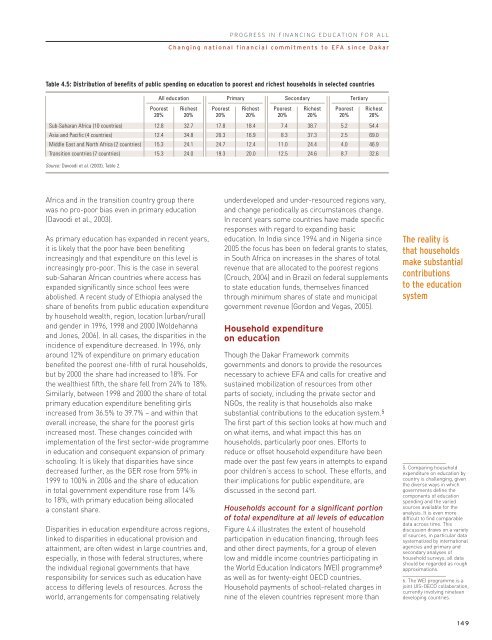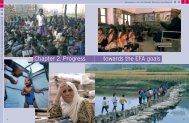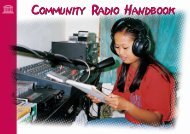Financing Education / pdf - Unesco
Financing Education / pdf - Unesco
Financing Education / pdf - Unesco
You also want an ePaper? Increase the reach of your titles
YUMPU automatically turns print PDFs into web optimized ePapers that Google loves.
PROGRESS IN FINANCING EDUCATION FOR ALL<br />
Changing national financial commitments to EFA since Dakar<br />
Table 4.5: Distribution of benefits of public spending on education to poorest and richest households in selected countries<br />
All education Primary Secondary Tertiary<br />
Sub-Saharan Africa (10 countries)<br />
Asia and Pacific (4 countries)<br />
Middle East and North Africa (2 countries)<br />
Transition countries (7 countries)<br />
Poorest<br />
20%<br />
Richest<br />
20%<br />
Poorest<br />
20%<br />
Richest<br />
20%<br />
Poorest<br />
20%<br />
Richest<br />
20%<br />
Poorest<br />
20%<br />
Richest<br />
20%<br />
12.8 32.7 17.8 18.4 7.4 38.7 5.2 54.4<br />
12.4 34.8 20.3 16.9 8.3 37.3 2.5 69.0<br />
15.3 24.1 24.7 12.4 11.0 24.4 4.0 46.9<br />
15.3 24.0 19.3 20.0 12.5 24.6 8.7 32.6<br />
Source: Davoodi et al. (2003), Table 2.<br />
Africa and in the transition country group there<br />
was no pro-poor bias even in primary education<br />
(Davoodi et al., 2003).<br />
As primary education has expanded in recent years,<br />
it is likely that the poor have been benefiting<br />
increasingly and that expenditure on this level is<br />
increasingly pro-poor. This is the case in several<br />
sub-Saharan African countries where access has<br />
expanded significantly since school fees were<br />
abolished. A recent study of Ethiopia analysed the<br />
share of benefits from public education expenditure<br />
by household wealth, region, location (urban/rural)<br />
and gender in 1996, 1998 and 2000 (Woldehanna<br />
and Jones, 2006). In all cases, the disparities in the<br />
incidence of expenditure decreased. In 1996, only<br />
around 12% of expenditure on primary education<br />
benefited the poorest one-fifth of rural households,<br />
but by 2000 the share had increased to 18%. For<br />
the wealthiest fifth, the share fell from 24% to 18%.<br />
Similarly, between 1998 and 2000 the share of total<br />
primary education expenditure benefiting girls<br />
increased from 36.5% to 39.7% – and within that<br />
overall increase, the share for the poorest girls<br />
increased most. These changes coincided with<br />
implementation of the first sector-wide programme<br />
in education and consequent expansion of primary<br />
schooling. It is likely that disparities have since<br />
decreased further, as the GER rose from 59% in<br />
1999 to 100% in 2006 and the share of education<br />
in total government expenditure rose from 14%<br />
to 18%, with primary education being allocated<br />
a constant share.<br />
Disparities in education expenditure across regions,<br />
linked to disparities in educational provision and<br />
attainment, are often widest in large countries and,<br />
especially, in those with federal structures, where<br />
the individual regional governments that have<br />
responsibility for services such as education have<br />
access to differing levels of resources. Across the<br />
world, arrangements for compensating relatively<br />
underdeveloped and under-resourced regions vary,<br />
and change periodically as circumstances change.<br />
In recent years some countries have made specific<br />
responses with regard to expanding basic<br />
education. In India since 1994 and in Nigeria since<br />
2005 the focus has been on federal grants to states,<br />
in South Africa on increases in the shares of total<br />
revenue that are allocated to the poorest regions<br />
(Crouch, 2004) and in Brazil on federal supplements<br />
to state education funds, themselves financed<br />
through minimum shares of state and municipal<br />
government revenue (Gordon and Vegas, 2005).<br />
Household expenditure<br />
on education<br />
Though the Dakar Framework commits<br />
governments and donors to provide the resources<br />
necessary to achieve EFA and calls for creative and<br />
sustained mobilization of resources from other<br />
parts of society, including the private sector and<br />
NGOs, the reality is that households also make<br />
substantial contributions to the education system. 5<br />
The first part of this section looks at how much and<br />
on what items, and what impact this has on<br />
households, particularly poor ones. Efforts to<br />
reduce or offset household expenditure have been<br />
made over the past few years in attempts to expand<br />
poor children’s access to school. These efforts, and<br />
their implications for public expenditure, are<br />
discussed in the second part.<br />
Households account for a significant portion<br />
of total expenditure at all levels of education<br />
Figure 4.4 illustrates the extent of household<br />
participation in education financing, through fees<br />
and other direct payments, for a group of eleven<br />
low and middle income countries participating in<br />
the World <strong>Education</strong> Indicators (WEI) programme 6<br />
as well as for twenty-eight OECD countries.<br />
Household payments of school-related charges in<br />
nine of the eleven countries represent more than<br />
The reality is<br />
that households<br />
make substantial<br />
contributions<br />
to the education<br />
system<br />
5. Comparing household<br />
expenditure on education by<br />
country is challenging, given<br />
the diverse ways in which<br />
governments define the<br />
components of education<br />
spending and the varied<br />
sources available for the<br />
analysis. It is even more<br />
difficult to find comparable<br />
data across time. This<br />
discussion draws on a variety<br />
of sources, in particular data<br />
systematized by international<br />
agencies and primary and<br />
secondary analyses of<br />
household surveys; all data<br />
should be regarded as rough<br />
approximations.<br />
6. The WEI programme is a<br />
joint UIS-OECD collaboration,<br />
currently involving nineteen<br />
developing countries.<br />
149

















